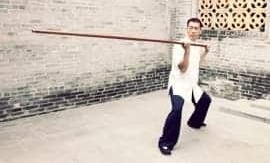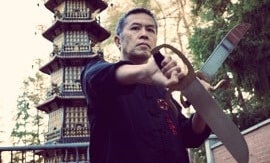
THE TERM SIFU IS COMMONLY HEARD OF WITHIN GUNG FU CIRCLES. THE CHINESE PICTOGRAM IS MADE UP OF TWO CHARACTERS, MEANING “TEACHER” AND “FATHER”, AND IS LOOSELY TRANSLATED INTO ENGLISH AS “MASTER”.
At its most basic level, Sifu implies a superior level of skill and status within a hierarchy. Indeed, the title is often used as a form of deference or respect. Derived from the term for “Teacher”, the title Sifu also suggests the ability to translate personal attributes into the development of others. This infers a superior knowledge that is coupled to the complex range of interpersonal skills that are required to transmit ideas and concepts.
There is no formal qualification required to become a Sifu. This is hardly surprising when considering the term is applied generally across a disparate range of martial arts, which do not bear any comparison, much less uniform systematisation. Even within specific arts, however, including Wing Chun, the accolade Sifu appears to be used fairly indiscriminately, with no obvious references to the user’s level of skill, knowledge or teaching ability.
In previous generations, a Sifu was typically an accomplished pugilist with a proven fighting prowess. Whilst this did not mean they were necessarily a good teacher, or indeed a person worthy of respect, the title is at least in context with the art of fighting and for the most part is largely unambiguous. It could be said that this is in response to the popularisation of martial arts, challenge fights and other forms of extreme pressure testing have largely disappeared, to the extent that Sifu may be little more than lip service to tradition and mutual acceptance between those running and attending classes.
The gifting of a status without benchmarks for quality presents a number of real dangers to a system. Most obviously, an incomplete or otherwise inadequate understanding of Wing Chun may be transmitted from one generation to the next. This process invariably leads to transcription errors and a deterioration in the quality of skills over time. Furthermore, even otherwise skilful practitioners are prone to drift off course. Without regular reference to equally skilful peers, ineffective technique variations may develop. While they may be well intentioned, individuals who assume leadership of a system without adequate knowledge and skill may subsequently lead to a progressive decline in its quality.
Status without adequate control permits more malevolent manifestations of “Sifuism”. Some individuals are driven to achieve the status; purely for reasons of self-esteem. Calling oneself Sifu may be a form of self-aggrandisement, serving maladapted personal needs far more readily than developing students. The mantle of assumed power also presents the opportunity for exploitation. The title of Sifu can add a superficial credibility to an otherwise blatant attempt at profiteering. It could also promote spurious techniques or even both. Despite the moral connotations of the term Sifu, the absence of formal control allows the title to be diluted to its lowest common denominator.
There is an abundant amount of evidence to support an argument that unqualified Sifuism, has unfortunately diluted the quality of Wing Chun taught. The most obvious examples are found in the growing number of Wing Chun publications. While popular interest in the system has grown to create this need, it is with a few exceptions, characterised by volumes most notable for their similarity and lack of real content or substance. There is very little to be gained by anyone, except the author from another volume of sequential photographs showing the performance of Siu Nim Tau. Whilst the term Sifu is often found on the cover, it is rarely reflected in a detailed and scientifically grounded prose.
Internet media and social networking offer a huge range of exhibits in the case placed against Sifuism. While bearing the superficial hallmarks of Wing Chun, there are countless video clips that are offering excellent examples of flawed techniques.
Incorrectly posing the basic stance and the Guard Hand (Wu Sau) are amongst the most common, observable errors. This is critical because these forms produce profound changes in the patterns of muscle activation that are essential for power generation and effective Wing Chun.
Both the Internet and printed text offer examples of Sifuism used for exploitation. Books regarding Dim Mak, or Death Touch, continue to remain steadfastly in circulation despite a complete lack of scientific foundation. One practitioner can be viewed online promoting themselves on their ability to incapacitate their students, without any physical contact, using Qi alone. From any rational standpoint, such claims are absurd and unfortunately demonstrate little more than the real potential for corruption in assumed authority.
A Sifu is nothing without their students, and the effects of Sifuism cannot be felt without them. In this respect, students must accept a share of the responsibility for their own training. Becoming a student carries many of the same dangers that come with assuming the mantle of Sifu. It is entirely feasible that a significant number of students are attracted to martial arts for reasons of self-esteem, malevolently spurred by their teachers. While this offers the potential for a virtuous circle of acceptance and mutual admiration, it may also undermine the otherwise healthy willingness to challenge someone’s beliefs and ideas.
At best this will stifle a student’s development, and at worst it will perpetuate potentially fatal errors. The need to conform should not be underestimated in any way. It is instructive that the Sifu who could incapacitate using Qi alone; could only do so with his own students. Mutual acceptance of an assumed hierarchy does not imply blind and unquestioning obedience.
In the final analysis, the effects of Sifuism are seen in the results that Wing Chun produces. The system is promoted as simple, effective and even relatively quick to learn. Based on sound biomechanical principles, Wing Chun should allow a smaller and weaker opponent to overpower a larger, more powerful one. Compared to alternative fighting systems to which similar claims could be made, however, it is highly questionable whether or not Wing Chun training is producing equally competent fighters.
Boxers train with fewer tools, but experience clearly demonstrates that even Wing Chun practitioners with years of training cannot effectively deal with a halfway decent boxer. This manifest failure in Wing Chun training is almost entirely attributable to those who assume the teaching of it.



















